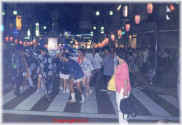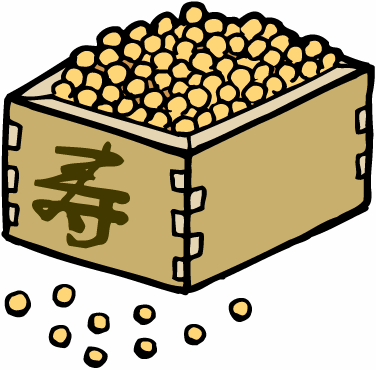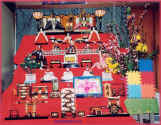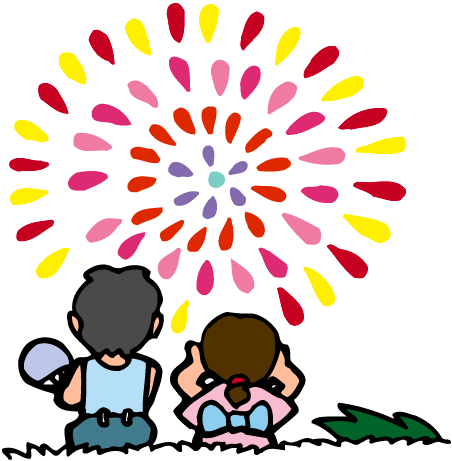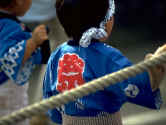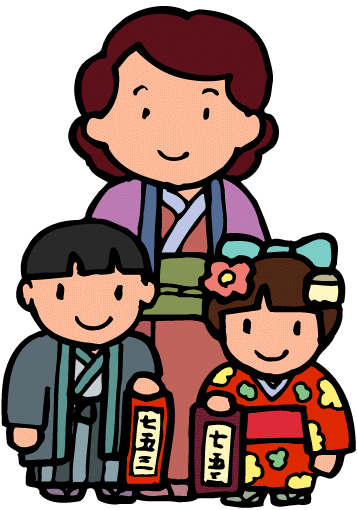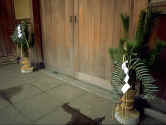|
Festivals and Holidays
|
|
There are many festivals and holidays in Japan. I will describe same of the most popular here. If you think I should include other festivals, then please let me know. The festivals originated in the farming communities, to pray for good harvests in the spring and to give thanks to the gods in the Autumn.
When towns started to develop, festivals were initiated to drive away evil spirits and pestilence. During the Edo period, festivals took on a new meaning as a popular form of recreation, whereby the people could forget their everyday troubles. After the second World War, the true meaning of there festivals began to fade and nowadays the festivals exist for the tourists and the local peoples enjoyment. There are also many newly created theme festivals.
|
February 3rd Setsubun Celebrated at home, dry beans are thrown onto the floor to chase away bad luck and evil spirits There is also a Setsubun festival at Sensoji Temple in Asakusa (Tokyo) where many beans are thrown into the crowds of people, often by famous people. |
|
March 3rd Hina Matsuri (Doll Festival) The roots of this festival go back to the Heian period. This is a time when girls pray for a good and timely marriage. Dolls are set out on display, often on tiered platforms. The dolls include an emperor and empress and many court officials. Red and white sweets are usually eaten by children.. Peach blossom, often decorate the home, because the festival used to be known as Momo no Sekku (peach festival). The dolls must be put away, very soon after March 3rd, otherwise, according to superstition, a girls marriage may be delayed, or she could be forever unwed. |
|
May 3rd or 4th Hakata Dontaku (Fukuoka prefecture) This festival is held every year and includes a procession of many people wearing colorful costumes. A major event in Fukuoka.
|
|
May 5th Tango no Sekku (children's day, formerly Boys Day) This is also a national holiday. Many parents by their sons, miniature Samurai Armour, Samurai dolls or helmets. Families also hang out Koi-nobori (carp streamers). In the countryside the carp streamers can reach great lengths, but in the cities, the length of the streamers are greatly restricted. This festival became popular in the Meiji period.
|
|
Mid May weekend Sanja Matsuri(Tokyo) This festival started out as a welcome to the summer. Many Mikoshis (portable shrines) are carried through the streets, to the accompaniment of percussion instruments and some wild dancing. The procession ends at Asukusa Shrine. This is a very popular festival. Many people go to watch, and it is usually impossible to see anything if you arrive late.
|
|
July 1st for the entire month Gion festival (in Kyoto) This festival lasts through the month. The highlight days are July 15th and 16th when there are many floats and musicians playing a variety of musical instruments very colorful at night.
|
|
July 7th Tanabata This festival originates in China. It came to Japan during the Nara period and is based on a legend of the cowherd star (Altair) and the Weave star (Vega). Two lovers who can only meet once a year on the seventh day of the seventh month of the lunar calendar. Today children will often write their hopes and wishes on multicolored pieces of paper, attached to bamboo poles, with Origami cranes and such, for display in the family garden. The bamboo poles are supposed to be thrown in a river to dispose of, soon after the day is over although it is usually not possible for those who live in the city.
|
|
Last Saturday of July Fireworks festival (Tokyo) The Sumida-gawa river (near Asakusa) is perhaps one of the best displays to be seen in and around Tokyo in the summer. But be warned, the river side gets extremely crowded with people, long before the fireworks display starts. Fireworks are a very popular source of summertime entertainment in Japan. Many families buy fireworks to let off, while having a barbecue in the evening.
|
|
August 1st-August 7th Nebuta Festival (Aomori) This famous festival takes place in the evening. Large floats with pictures of ancient Chinese hero's and famous Japanese Samurai are lit from within and paraded through the streets. The festivals closing ceremony features the floats being set adrift at sea return to this world.
|
|
August 13 and 15th. Bon-Bon Odori This is one of the big holidays in Japan. A time when many Japanese return to their hometowns and pray at their ancestors graves or small Buddhist family alters. Communities across Japan erect a scaffold tower in the middle of a square, where musicians will play flutes and drums with dancers circling the tower. If you visit such a dance, you may very well, be asked to join in. Later you may be given a small prize (present) for your dance. You are sure to have a good time.
|
|
Yosakoi Matsuri A summer festival held in Kochi prefecture. Tens of Thousands of participants dance along the main streets in Kochi city and holding two Narukos,(a kind of musical instrument) and with Yosakoi songs, which can be arranged as rock, Latin, pop or any kinds of music. This old song is about a Buddhist monk who bought a hair accessory for a girl whom he loved. How you dance is solely up to you as long as you are holding two Narukos. This attracts many dancers who even have to pay to participate approximately 10,000 yen for each dancer, the dance team has a band which plays their own Yosakoi music, and therefore the viewers can enjoy watching different kinds of music and dance. The best dance teams are later chosen and commended. The festivals last through 3 days.
|
|
Awa Odori A dance festival held in Tokushima prefecture. This might be more famous than Yosakoi Matsuri as a summer festival in Shikoku island. The lyric of this characteristic song says something like 'There are fools who dance. There are fools who watch the dance.' The dance is also characteristic and monotonous.
|
|
Mid October to Mid November Kiku Matshuri (Tokyo) This is a chrysanthemum show, which is held at Sensoji Temple in Asakusa. The chrysanthemum, of course, is Japans national flower. You can also buy some chrysanthemums in pots at the temple.
|
|
November 15th Shichi-go-san (七五三:7-5-3) A children's celebration. When a boy reaches the age of 3 or 5 years old and a girl 3 or 7 years old. They are dressed up and often pay their respects at the local shrine or temple.
During the Edo period the Samurai class observed various rites. Boys and girls aged 3 were allowed to grow their hair long. Boys aged 5 could start wearing Hakama (a divided skirt worn by men:袴). Girls 帯)instead of rope to tie their Kimonos. Nowadays it is completely commercialized with shops, photo studios, and so on, pushing for business. Many parents rent a Kimono from a photo studio for the time it takes, to take a picture in the studio. All inclusive prices can cost from 30.000 yen upwards for a few pictures. Buying a Kimono set can be prohibitively expensive, with prices over 100.000 yen not uncommon, the Kimono can only be worn on a very few occasion. |
|
|
|
End of the year Shogatsu-yasumi This end of year holiday is one of the longest for many workers, and offices and factories close down. The holiday generally starts around December 28th or 29th and finishes on the 5th or 6th January. Many people visit shrines or temples from December 31st onwards. You will be able to see many Japanese women wearing Kimonos during this holiday. If you have the chance, visit one of the shrines, Iwould recommend after January 4th, when there shouldn't be too many people. You will be able to buy some interesting souvenirs. For example lucky arrows, miniature garden rakes, and so on, which will bring you good luck fro the coming year. |
This page was automatically updated on 01/03/13 05:15:45


